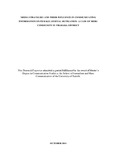| dc.description.abstract | Female Genital Mutilation (FGM) or female circumcision is one of the traditional practices whose origins can be traced to ancient times. In Kenya, the prevalence varies widely among ethnic groups. Kenya Demographic Household Survey (2009), shows it is nearly universal among Somali (97%), Kisii (96%), Kuria (96%) and Maasai (93%) women. It is also common among Taita/Taveta (62%), Kalenjin (48%), Embu (44%) and Meru (42%). Levels are lower among Kikuyu (34%), Kamba (27%), Turkana (12%) and Mijikenda/Swahili (6%). This is a clear indication that FGM is widely practiced in Kenya. This study sought to establish the influence of media strategies in communicating information about female genital mutilation effectively among the Meru community of Tharaka District. The study was guided by the following specific objectives: (1) to establish the influence of using media ambassadors (2) to determine the influence of using local language (3) to determine the influence of using Sheng and ((4) to examine the influence of public participation in media programs in communicating information about female genital mutilation effectively among the Meru community of Tharaka District. The study adopted a descriptive Survey approach to research; using primary data for both quantitative and qualitative analysis. The data was collected by use of questionnaires and interviews guide. The target population for this study was the 44,451 households, with a sample size of 96, although the researcher collected 120 responses. The researcher adopted stratified random sampling technique given that Tharaka District is divided into two Tharaka South and Tharaka North. Purposive sampling was used to identify the households to select with the help of the administrative officers and also the key informants whom administrative officers, the study used stratified random. Quantitative data was analyzed using descriptive and inferential statistics while qualitative data was analyzed using content analysis. Correlation analysis revealed that media ambassadors and local language were positive and statistically significant in influencing effective communication. Conversely, the analysis revealed that sheng language and public participation were not statistically significant in influencing effective communication. The study concluded that media ambassadors influenced effective communication of FGM information. This implies that more involvement of media ambassadors in anti FGM campaigns would improve effective communication of FGM information. The study also concluded that local languages influenced effective communication of FGM information. This implies that more use of local language in anti FGM campaigns would improve effective communication of FGM information. Further, the study concluded that sheng language and public participation do not influence effective communication. It can be concluded that media strategies have a key role to play in communicating anti- FGM information among the Meru community of Tharaka District. | en_US |

